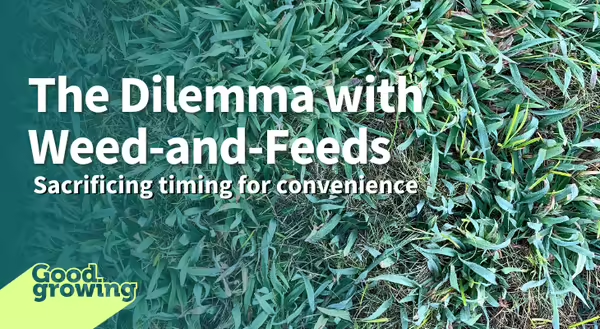
As the winter’s chill lingers into spring, the itch to get out in our yards has never seemed more compelling. One of the ritual tasks performed by many homeowners in the spring is applying weed-and-feed products to their lawns. Contained within these products is a pre-emergent herbicide to combat germinating weed seeds and then a helpful boost of nitrogen fertilizer to give our lawns that lush green appearance. Weed-and-feeds are a wonderful product of convenience by combining two tasks into one application- ideal for the weekend gardener, but not ideal for our lawns.
Pre-emergent herbicide’s method of control is to inhibit the germination of seeds or kill emerging seedlings. This means the homeowner must apply the chemical before the seed germinates. Let’s use crabgrass as an example: We know that crabgrass germinates when soil temperatures rise above 55°F to 60°F for 7 to 10 consecutive days, so we must apply our pre-emergent about a week or two before the soil temperatures reach that window. Why so early? Because it can take time for the chemical to move in the soil where the crabgrass seed awaits. In Central Illinois, crabgrass typically germinates by mid-April. Therefore, crabgrass control is commonly applied in early April.
So what’s the problem with crabgrass preventative weed-and-feed? While crabgrass is germinating, our lawns are focusing much of their energy on root development to prepare for summer. As was mentioned prior, fertilizer gives that nice flush of green growth we so desire in our lawns. Nitrogen, the main nutrient in most lawn fertilizers, is the element that stimulates green leafy growth in plants. By applying nitrogen and stimulating vegetative growth too early, the turf shifts more energy to vegetative growth and is left with an inadequate root system and a lawn that may be less resilient during a hot, dry summer.
A weed-n-feed is a product of convenience, but it sacrifices the appropriate timing of the product’s application. A crabgrass preventer is ideally applied early in the spring. While fertilizer is applied following the strong natural flush of springtime lawn growth, typically mid-May for Central Illinois.
It is pretty common for homeowners to fertilize their lawns once per year. While it does not hurt the lawn to fertilize in the spring, the ideal timeframe to fertilize a cool-season lawn is late summer into early fall. A fertilizer application later in the summer allows our cool-season lawns to recover from a hot summer.
To combat crabgrass this spring, locate an herbicide product that does not contain any fertilizer. This may be tough to find in some of our big box stores, so you may need to try a few different locations, speak to a local garden center, or order online.
If a company treats your lawn, call them up and ask them to leave out the fertilizer when they are making their pre-emergent application this spring. Apply fertilizer later in the spring as temperatures warm up to the point where the lawn begins to slow down on vegetative growth, usually by mid-May.
To track soil temperatures in your area so you can time your crabgrass application perfectly, you can monitor your soil temperature using a fancy soil thermometer or not so fancy meat thermometer. Illinois State Water Survey has soil temperature monitoring stations throughout the state. Or contact your local Illinois Extension office.
Good Growing Tip of the Week: If you don’t like the idea of applying an herbicide to your lawn but want to do something about crabgrass. Consider setting your mower height between three to four inches. This will make your lawn more competitive with crabgrass and many other weeds.
Sign up for our emails! Want to get notified when new Good Growing posts are available? SIGN ME UP
MEET THE AUTHOR
Chris Enroth is a horticulture educator with University of Illinois Extension, serving Henderson, McDonough, Knox, and Warren counties since 2012. Chris provides horticulture programming with an emphasis on the home gardener, landscape maintenance personnel, and commercial landscapers. Additional responsibilities include coordinating local county Master Gardener and Master Naturalist volunteers - providing their training, continuing education, advanced training, seasonal events, and organizing community outreach programs for horticulture and conservation assistance/education. In his spare time, Chris enjoys the outdoors, lounging in the garden among the flowers (weeds to most).